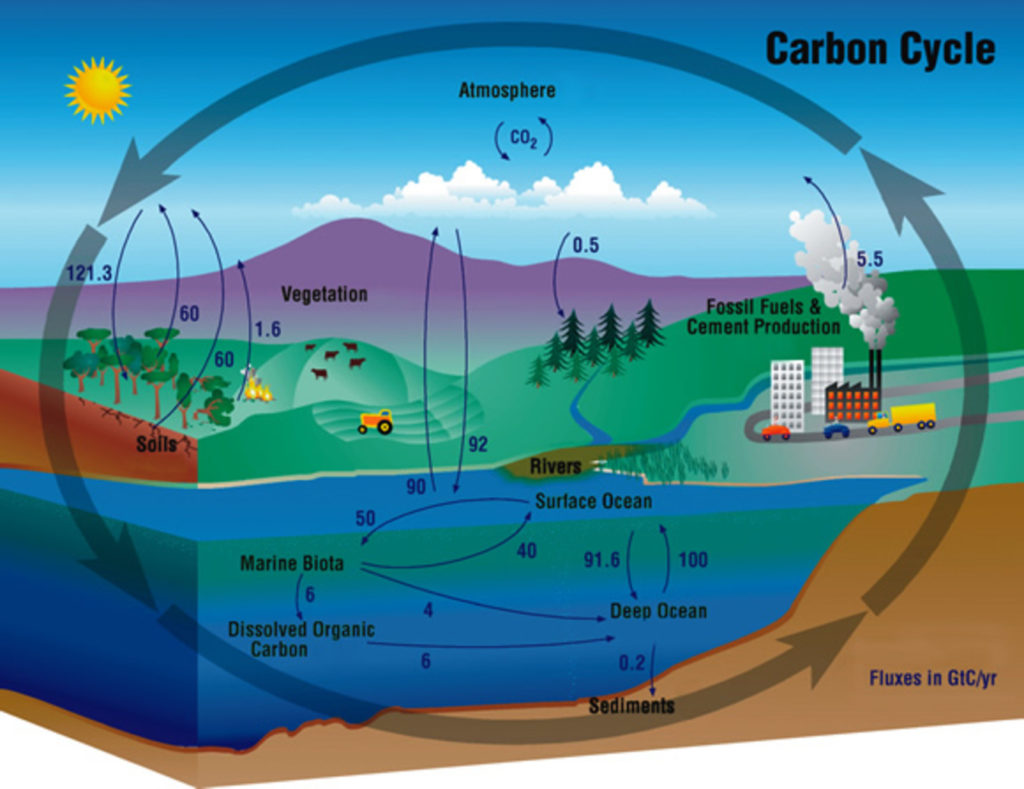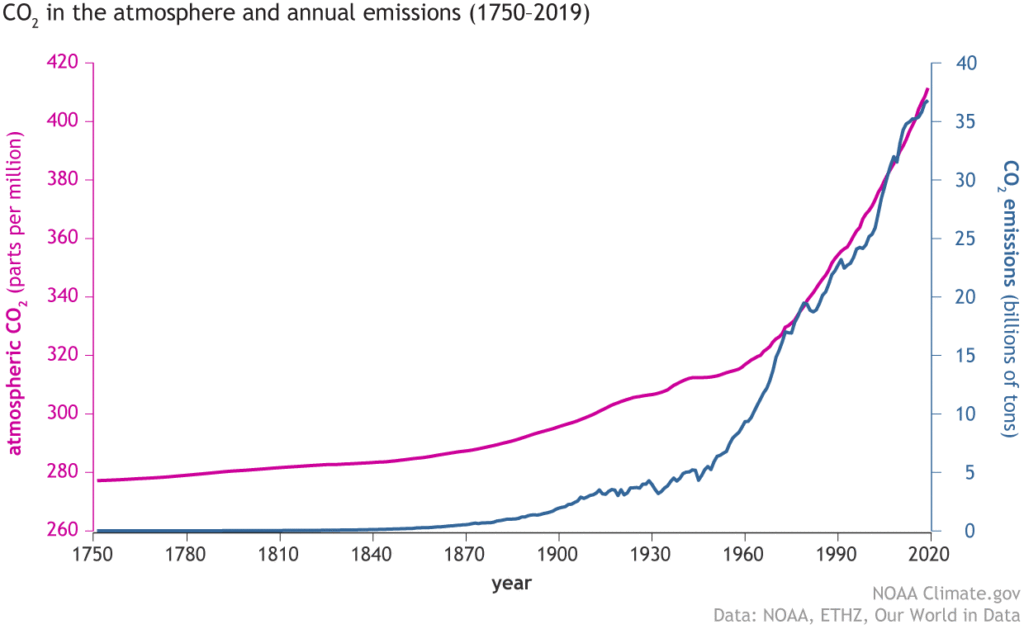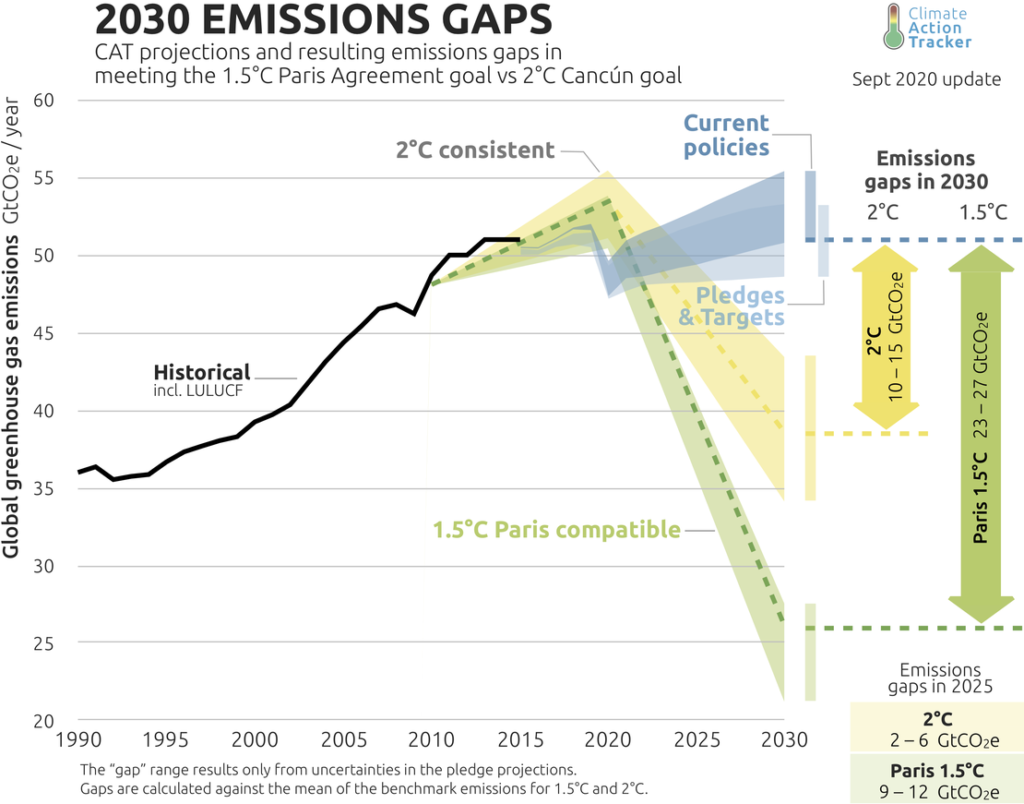Svante Arrhenius, the Swedish scientist, and Nobel Prize laureate was the first (1896) to develop a theory and calculate how increases of carbon dioxide (CO₂) in the atmosphere will increase the Earth’s surface temperature. He also concluded that anthropogenic (human caused) CO₂ emissions, even though much smaller than natural forces, are large enough to contribute to the warming. He calculated that a doubling of CO₂ concentration in the atmosphere would lead to a 5°C temperature rise. However, at that time increased temperatures were regarded more positive than negative, not least reducing the risk for a new ice age.
It was not until the 1980s it started to be more universally acknowledged that the Earth’s climate was getting warmer and the negative effects becoming serious concern. In 1988 the Intergovernmental Panel on Climate Change (IPCC) was formed. With more than 2500 scientists from over 60 countries IPCC has developed models and presented climate change reports, the first one in 1992. In response to criticism and skeptics, as well as based on new discoveries the models have continued to develop.

Today, the vast majority of climate scientists have concluded that the carbon cycle is very slow and that the oceans are not absorbing all the increase of the greenhouse gases, CO₂ₑ (see footnote). Measurements of CO₂ in the atmosphere show that it is increasing. The concentration of CO₂ was about 280 ppm before the industrial revolution. Today (2020) it has reached 416 ppm. If no actions are taken, it is expected that by 2060 it will reach 560 pm.

560 ppm is twice the concentration as the pre-industrial level. It is also a key measurement of “equilibrium climate sensitivity” (ECS), how much the earth can be expected to warm. Jules Charney, a US meteorologist, presented 1979 an estimate of a possible range of 1.5°C to 4.5°C. This year (2020) a group of climate scientist (Forster, Hausfather, Hegerl and Sherwood) concluded after four years of research and using more detailed data that ECS range likely be 2.6°C to 4.1°C.
Recognizing climate change as a global problem the international community has tried to come together to find a global solution. The first initiative was the Earth Summit in Rio de Janeiro in 1992. One of the outcomes was the United Nations Framework Convention on Climate Change (UNFCCC), where 197 ratifying parties committed to the objective of stabilizing the GHG concentrations in the atmosphere, but it was a non-binding commitment.
The Kyoto Protocol of 1997 aimed at reducing GHG to “a level that would prevent a dangerous anthropogenic interference with the climate system”. The Protocol differentiated between developed and developing countries putting almost all the burden to cut emissions on the developed countries. Consequently, with more than 100 developing countries including China and India exempted, it was not a complete surprise that GHG emissions continued to rise. In fact, they increased with over 30% from 1990 to 2010.
The Paris Agreement in 2015 made no exemptions but took note of a pledge by the developed countries to jointly contribute $100 billion per year 2020-2025 to address the climate finance needs of developing countries. The Agreement targets to keep the increase in global temperatures to below 2°C above pre-industrial levels and to pursue efforts to limit the increase to 1.5°C. Each signatory country must determine, plan, and regularly report their actions. However, there is no binding enforcements.
While many countries have embraced the less than 2°C target and are making major efforts to reduce CO₂ and other GHG emissions, the aggregated global results are coming short of the targets. The annual amount of GHG emissions are presently over 50 Gt (giga tons) per year. In the early 1990s it was slightly over 30 Gt. The concentration of CO₂ₑ in the atmosphere continues to increase. IPCC predicts that by 2030 it will 52-55 Gt. Climate Action Tracker estimates that the emissions must be reduced to 37 Gt annually to achieve the goals of limit the global temperature increase to 2°C. To limit the increase to 1.5°C emissions need to come down to 26 Gt per year. However, it is a moving target. The more CO₂ₑ continues to accumulate in the atmosphere, the more the reductions must be to reach the temperature goals.

As Christine Nunez points out (National Geographic Jan 30, 2019): “In any discussion about climate change, renewable energy usually tops the list of changes the world can implement to stave off the worst effects of rising temperatures. That’s because renewable energy sources such as wind don’t emit carbon dioxide or other greenhouse gases that contribute to global warming.”
No doubt wind and solar will be major components for greenhouse gas reductions, but more is needed in order decarbonize not only the electric power sector but also other sectors like industry, transportation, agriculture, and buildings.
Globally, the power sector is (2015 data) the biggest source of emissions, 31%, and within this sector coal is the biggest source. So far most of the coal that has retired, has been replaced by natural gas fired combined cycle gas turbines (CCGT), driven more by economics than by mandates. A state-of-the-art CCGT emits 40-50% less than a conventional coal power plant. In fact, this transition has been the main reason behind the 12% reduction of energy related CO₂ emission between 2005 and 2018 in the USA. During the same time, the corresponding global number was an increase of 24%. Natural gas will continue to play an important role in the transition from coal, but ultimately it is a fossil fuel and long-term seen as a “transitional fuel”.
Globally, China is (2016 data) the biggest emitter of CO₂ₑ, 28%. United States is at 15%, followed by India at 7%. In China coal represents about 70 % of the electric power generation. The plans are to reduce coal’s proportion to 32% by 2050. Natural gas, domestic and imported, and nuclear will be part of the transition, but by far most of the new generation will come from renewable energy sources, in particular wind and solar. By 2050 the target is that renewable energy sources will be 55%. It will be a massive expansion. China is already the biggest in the world in terms of installed generation of hydro, wind and solar!
Despite all efforts to reduce GHG, it looks very challenging to reach the 2050 emissions goal to keep the increase in warming to 2°C. Given the big projected emissions gaps, carbon capture utilization and storage (CCUS) is getting renewed attention, not only to capture CO₂ in industrial processes and power generation, but also direct air capture.
Achieving the climate goals is possible. It will require public support and political will, globally, with a strong(er) sense of urgency. Technologies are already available, and in the 30 years up to 2050, even without break-through developments there will be substantial progress thanks to “just” evolutionary developments and economy of scale.
Footnote: Greenhouse gases are a set of gases: carbon dioxide, CO₂, (76%), methane, CH₄, (16%), nitrous oxide (6%) and fluorinated gases (2%). Using the dominant gas, CO₂, as the denominator the other gases are translated to CO₂ equivalents, CO₂ₑ. Discussing climate change and global warming, the expression “carbon” generally refers to CO₂ₑ. Decarbonization refers to reduction of CO₂ₑ into the atmosphere.
More read: About carbon capture utilization and storage: Emit- Capture – Utilize – Store
Reinventing Fire by Amory B. Lovins and Rocky Mountain Institute (2011). “Bold Business Solutions for the New Energy Era.”
Designing Climate Solutions by Hal Harvey with Robbie Orvis and Jeffrey Rissman (2018). “A Policy Guide for Low-Carbon Future.”
The New Map by Daniel Yergin (2020). “Energy, Climate, and the Clash of Nations.”